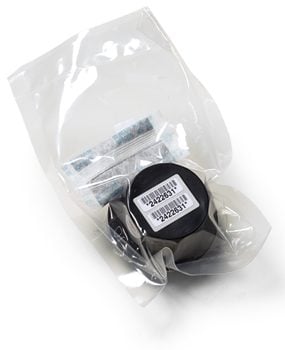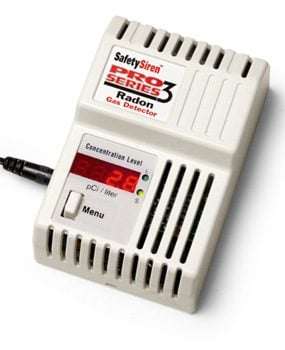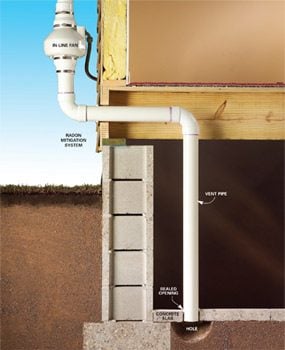What is Radon and How to Test For It
Updated: Feb. 17, 2023We will tell you how to test for radon in homes, how to stop radon and answer what is a radon mitigation system

Straight answers to key radon questions
A decade ago, media hype caused both panic and skepticism about the risks and effects of radon. Now, better research has made two things clear: Elevated levels of radon over a long period of time can cause lung cancer, and there are effective ways to reduce these levels.
While questions still remain over the quantities and length of exposure, radon concerns are a fact of homeownership. Most residential real estate transactions require radon testing, and many states require radon mitigation for new construction. This article will help you figure out whether your home has high radon levels and what you can do to reduce radon levels.
What’s the big deal about radon?
What is radon and what causes radon gas?
Radon is a colorless, odorless radioactive gas that’s produced by decaying uranium. Radon present in nearly all soils, and very low levels of radon gas are found in the air we breathe every day.
Why is radon a problem?
The problem occurs when radon gas enters your home and gets trapped. Long-term exposure to high levels of radon can cause lung cancer.
How does radon gas enter a home?
Radon gas moves from the soil into a home. Although radon can seep directly through pores in concrete, the worst entry points of radon are gaps in walls and floors. Any house, of any age, in any state can have elevated radon levels. It really depends on the way your specific house interacts with the surrounding soil. Your neighbor’s radon level may differ significantly from yours.
A Family Handyman Field Editor’s radon experience
“I created a radon problem when I insulated my crawl space and blocked some vents. Moving some insulation was all it took to clear up our problem. My advice is to try the simple solutions first.”
Matt Haun, Field Editor
How to test for radon gas
Conduct the test in the lowest livable area of your house that is regularly used 8 to 10 hours per week.
Short-term radon tests
Short-term tests are useful to see if further testing is warranted. Most are activated charcoal-based or electret ion that measure radon levels for two to seven days. You mail the tests to a lab for the results. Short-term tests are available at home centers, hardware stores and online retailers.
Long-term radon tests
Long-term tests measure levels for 90 days to one year. Most, such as the AccuStar test shown in the photo, are based on alpha particle tracking. This is a more accurate indicator of average annual levels in your home, which can vary significantly from day to day and month to month based on factors such as a drop in air pressure, gusty winds, variable soil moisture, and snow cover, which traps radon gases.
Long-term radon tests are available through state radon agencies and online retailers.
Continuous radon tests
Continuous electric monitors, such as the Safety Siren Pro Series digital meter in the photo (available from online retailers), plug into a standard outlet. These monitors can be used for both short-and long-term testing and give you a running average. They use an ionization chamber and sample the air continuously. Consider sharing the monitor and costs with neighbors.
When to take action
The EPA recommends doing a second test if an initial short-term test registers 4 picoCuries per liter (pCi/L) or higher. A long-term test will give you the most accurate information, but a short-term test is acceptable if you need the results quickly, such as for a real estate transaction, or your first levels registered 8 pCi/L or higher.
If a second test registers above 4 pCi/L, consider taking steps to reduce radon levels in your home.
How to reduce radon levels
Try these easy repairs to reduce radon gas levels. These efforts alone rarely reduce levels significantly, but if your level is only slightly elevated, these repairs might make the difference. They will also make other radon reduction methods more effective and cost efficient.
Once you’ve tackled these, retest. If levels are still high, consider installing a radon mitigation system yourself or hire a pro.
What is a Radon Mitigation System: DIY advice from an expert
According to radon mitigation expert Val Riedman, a skilled DIYer can usually install a fan and exhaust system (see “The Ultimate Solution” below) for a few hundred dollars for radon mitigation. “I’ve helped hundreds of DIYers reduce their radon levels to acceptable levels,” says Riedman. “And while installing a radon mitigation system isn’t always a simple project, DIYers with the right information, a working knowledge of tools, and an understanding of their home’s construction techniques can install an effective system.”
Riedman says houses that are good candidates for a DIY system have a basement that sits on top of a gravel base or have a sump system and drain tile.
“If you’re considering installing a radon mitigation system yourself,” says Riedman, “it’s very important to know what you’re doing so you don’t increase radon levels or cause combustion appliance backdrafting, which can increase carbon monoxide levels in your home.”
Other good DIY resources are your state’s radon office and the EPA’s detailed guides at epa.gov/radon/pubs.
The ultimate solution
The most effective system is a vent pipe placed in the sump pit (if you have a sump pump) or a hole made under your concrete floor slab. A special in-line radon fan is placed in the attic or outside the house to draw air through the vent and radon from under the basement floor. The easiest method is to run the vent out the side of the house and up to the eaves. You can also run the vent up through the house and out the roof, which is a lot more work and cost, but it looks better.
Pros usually charge between a few hundred and a few thousand dollars to install a radon mitigation system, depending on your home and your radon levels. Your state radon office will have a list of qualified contractors.
Don’t panic if there is radon in your house
Act, but don’t overreact. The risks from radon are cumulative, which means serious effects result from exposure to high levels over a long period of time. It is prudent to test radon levels and decide on a course of action. But you don’t have to move out of your house or hire the first contractor who can fix the problem. For more information, contact your state radon office for EPA guidelines for radon testing at epa.gov/radon/whereyoulive.html.
Required Materials for this Project
Avoid last-minute shopping trips by having all your materials ready ahead of time. Here’s a list.
- Continuous radon tester
- Long-term radon tester
- Short-term radon tester
Additional Information
- How radon gets into a house
- How to stop radon from getting into a house
- DIY radon reduction system tips
- 10 radon reduction questions answered




